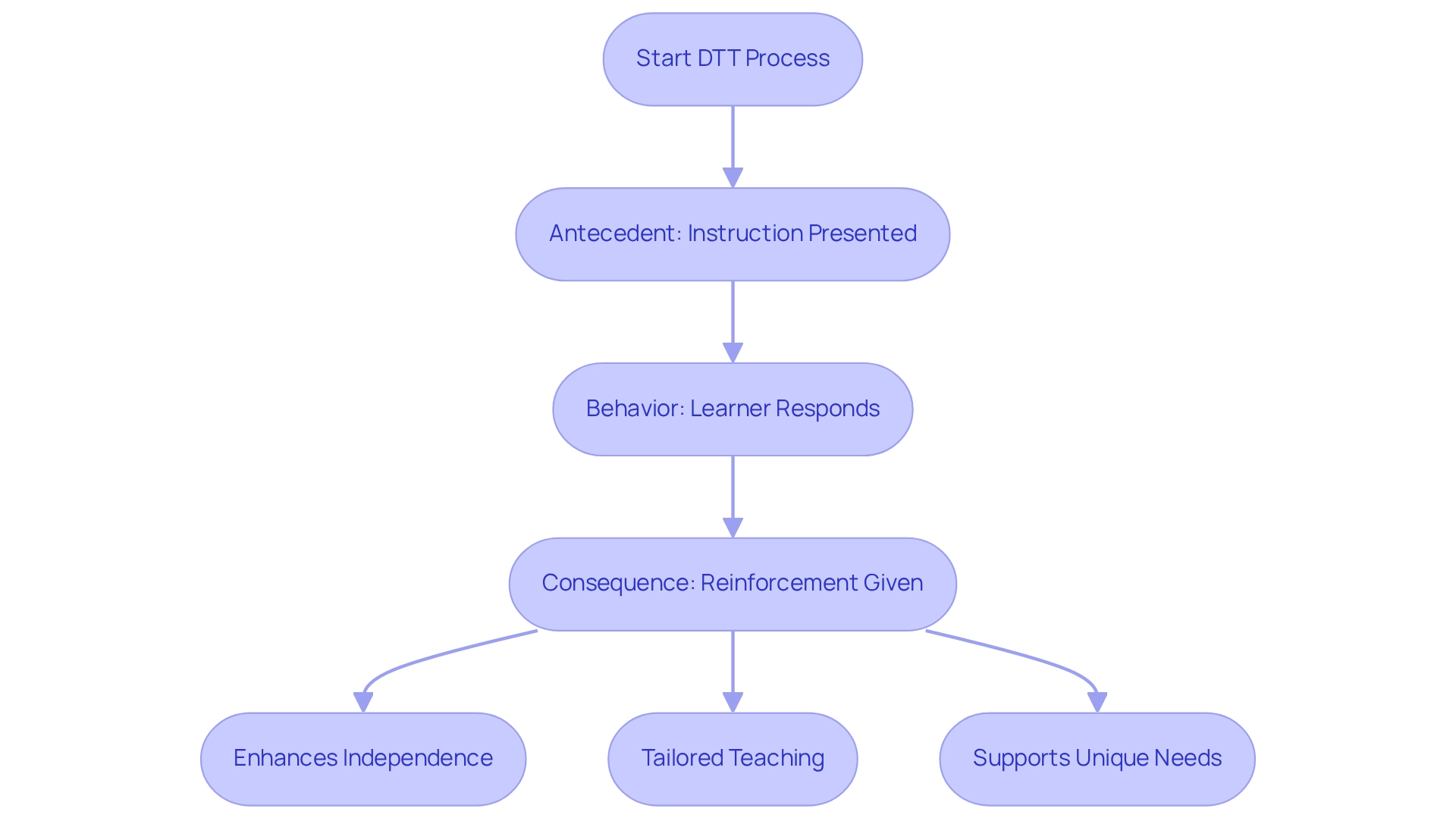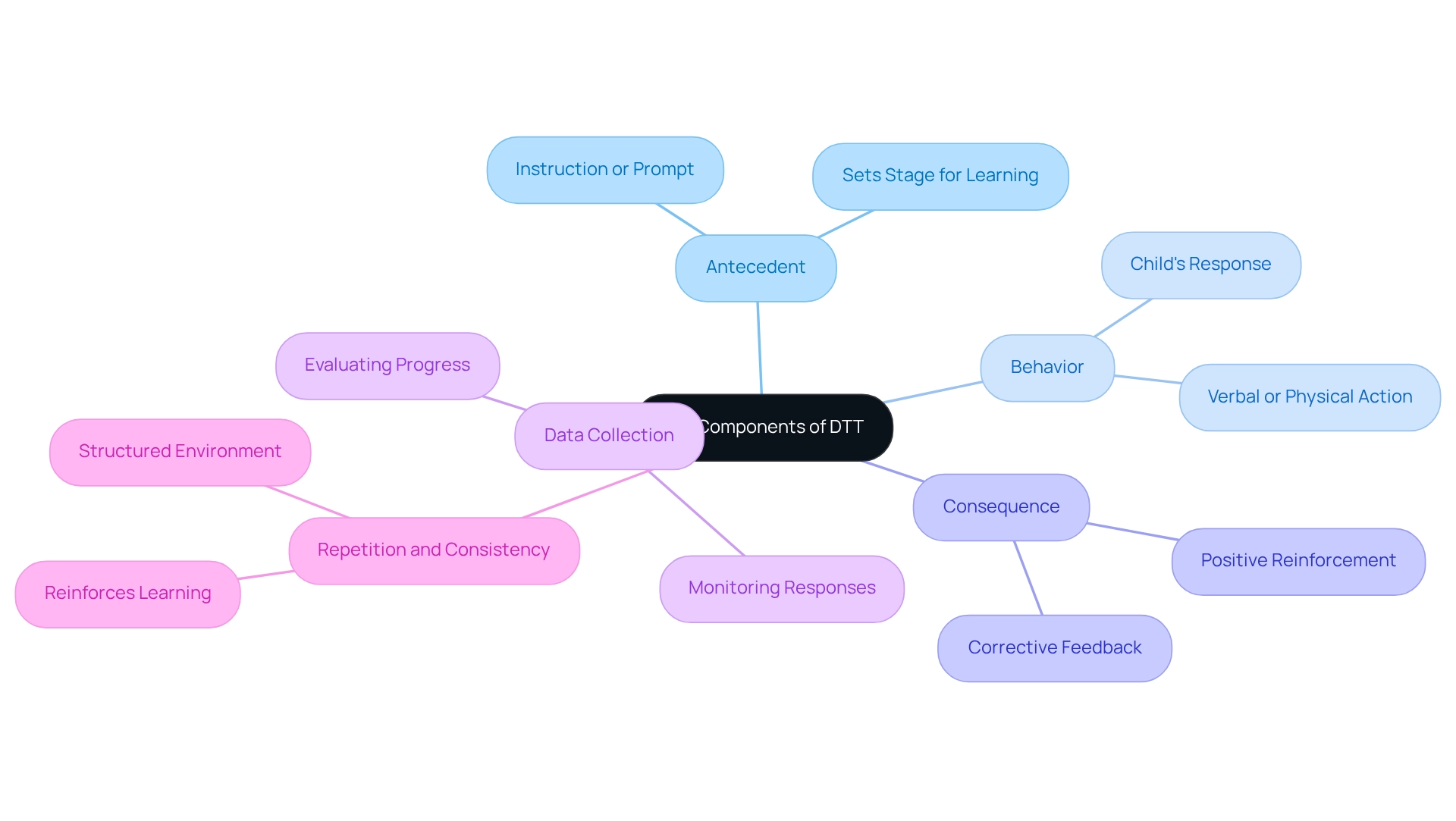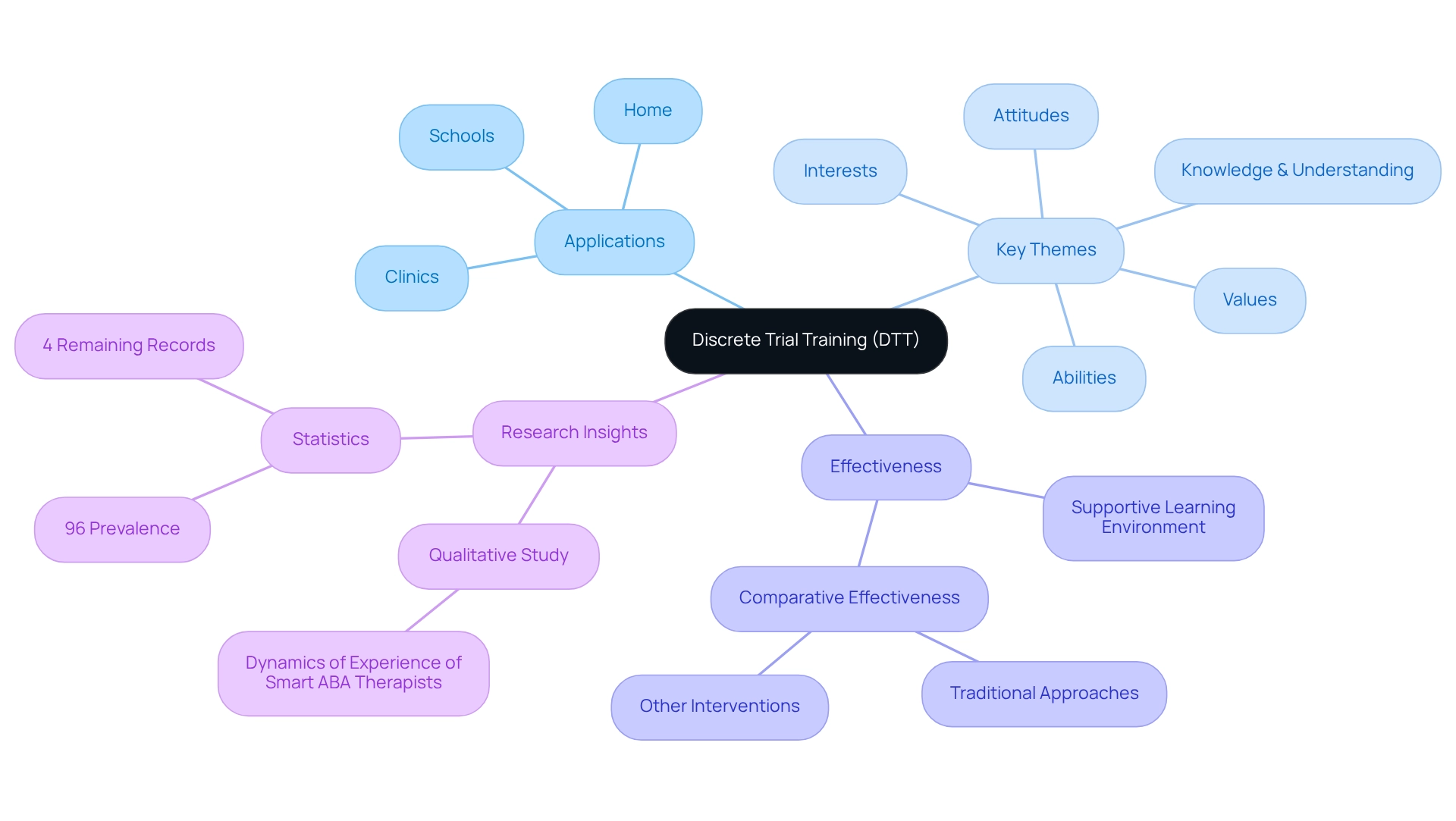Overview
Discrete Trial Training (DTT) in Applied Behavior Analysis (ABA) is a compassionate and structured teaching method designed to break down skills into smaller, manageable components. This approach places a strong emphasis on repetition and reinforcement, making learning more accessible, especially for individuals with autism. Understanding the historical development of DTT, along with its key components and practical applications, reveals its profound effectiveness in fostering independence and enhancing daily living skills for children with developmental disorders.
As parents, it’s essential to recognize the challenges faced by our children and how methods like DTT can offer support. Imagine witnessing your child gradually mastering a skill that once seemed insurmountable. This method not only nurtures their abilities but also instills a sense of accomplishment and confidence.
We invite you to explore the possibilities that DTT can bring into your child's life. By embracing this approach, you're taking a significant step toward empowering your child, fostering their independence, and improving their quality of life. Together, let’s support our children on this journey toward growth and development.
Introduction
In the world of Applied Behavior Analysis (ABA), Discrete Trial Training (DTT) emerges as a crucial instructional strategy, especially for children with autism and developmental disorders. This approach simplifies complex skills into smaller, manageable segments, facilitating focused teaching through a structured framework of antecedents, behaviors, and consequences.
Originating from the pioneering work of Dr. Ivar Lovaas in the 1960s, DTT has transformed into a foundational element of effective educational practices, showing measurable success in promoting independence and enhancing daily living skills.
As the need for personalized interventions increases, grasping the nuances of DTT—its components, historical significance, and practical applications—becomes vital for educators, therapists, and families. This understanding paves the way for meaningful progress in the lives of those it supports, fostering hope and empowerment in their journeys.
Define Discrete Trial Training (DTT) in ABA
The concept of DTT meaning ABA refers to a compassionate and systematic instructional method within Applied Behavior Analysis that breaks down abilities into smaller, manageable components. Imagine a world where each ability is taught through a series of discrete trials, consisting of three key components:
- An antecedent, where a specific instruction is presented;
- A behavior, where the learner responds;
- A consequence, typically involving reinforcement.
This organized approach is especially beneficial for individuals with autism and other developmental disorders, as it allows for concentrated and personalized teaching tailored to each learner's unique needs, particularly through DTT meaning ABA, which emphasizes repetition and consistency that are vital for reinforcing learning and promoting skill acquisition.
Recent studies suggest that DTT significantly enhances the ability of individuals with autism to carry out daily activities independently, fostering greater self-reliance and confidence. For instance, consider the case study titled 'How ABA Therapy Supports Independence in Daily Tasks for Youth,' which illustrates how ABA therapy empowers individuals with autism to manage daily tasks on their own, showcasing the effectiveness of DTT in real-world situations and highlighting the DTT meaning ABA.
Moreover, statistics reveal that many individuals with autism benefit from DTT, solidifying its role as a fundamental method in ABA therapy. As highlighted by ASD Media, after having their children diagnosed and prescribed ABA therapy by a local doctor, families began treatment shortly after, underscoring the importance of timely intervention. By utilizing DTT meaning ABA, practitioners can effectively address the diverse learning styles of youth, making it an essential component of ABA therapy that promotes independence.
We encourage parents to explore DTT further and consider how it might support their child's journey toward autonomy.

Explore the Historical Development of DTT
Discrete Trial Training (DTT) emerged in the 1960s, thanks to the dedicated efforts of Dr. Ivar Lovaas at the University of California, Los Angeles (UCLA). His groundbreaking research focused on harnessing behavioral principles to support children with autism, demonstrating how structured teaching methods could lead to significant improvements in learning outcomes.
Dr. Lovaas laid the groundwork for what is now known as DTT meaning aba, which prioritizes clear, measurable goals and data-driven strategies. As he wisely stated, "If they can't learn the way we teach, we teach the way they learn," reflecting his commitment to adapting teaching methods to meet individual needs in ABA therapy.
Over the years, DTT has evolved, incorporating insights from behavioral science and educational psychology, which has enabled its widespread use in various therapeutic environments. A compelling case study, titled "Development of Discrete Trial Training (DTT) Procedure in Smart Applied Behavior Analysis (Smart ABA) for Autism," showcases the practical application of DTT and its positive impact on learning outcomes.
Additionally, research published in the Journal of Psychology and Behavior Studies highlights DTT's vital role in modern autism interventions. This evolution underscores the method's enduring significance within the ABA framework, particularly in relation to dtt meaning aba, as it continues to adapt to the needs of children and families seeking effective support.
We encourage you to explore these resources and share your own experiences, as together we can foster a deeper understanding and support for those on this journey.

Identify Key Components and Structure of DTT
Understanding the key components of Discrete Trial Training (DTT), often referred to as dtt meaning aba, is essential for its effectiveness in Applied Behavior Analysis (ABA), especially for parents seeking the best for their children. Let’s explore these components together:
- Antecedent: This is the instruction or prompt given to your child, setting the stage for the expected behavior. Think of it as the starting point for learning.
- Behavior: Here, your child responds to the antecedent, which can be a verbal or physical action. This moment is crucial as it reflects their understanding and engagement.
- Consequence: After the behavior, a consequence follows. This might be positive reinforcement—like praise or tokens—or corrective feedback to guide your child. It’s all about encouraging growth and learning.
- Data Collection: Continuous monitoring and recording of your child’s responses are vital. This process helps evaluate progress and refine teaching strategies, ensuring that your child receives the best support possible. Effective data collection methods inform necessary adjustments, enhancing the overall learning experience.
- Repetition and Consistency: DTT emphasizes repeated practice of skills within a structured environment. This approach reinforces learning and helps ensure mastery, making it easier for your child to thrive.
Research shows that early intervention using DTT can lead to a remarkable 25% improvement in language therapy outcomes compared to non-ABA programs. This statistic highlights the significance of structured approaches in achieving developmental milestones. Additionally, insights from case studies, like those of Smart ABA therapists, reveal that competence in these key components is crucial for effective therapeutic services.
A qualitative study identified five key themes—knowledge & understanding, abilities, values, attitudes, and interests—that underscore the importance of ongoing training and policy support in autism interventions. As Riyan Betra Delza noted, "The findings of this study are crucial in revealing diverse aspects of the valuable experiences of Smart ABA therapists." This reinforces the need for parent advocates to engage with the latest findings in Applied Behavior Analysis through platforms like ResearchGate. By doing so, you can enhance your understanding of DTT meaning aba and its applications, ensuring you are well-equipped to support your child’s journey.

Examine Practical Applications and Examples of DTT
Discrete Trial Training (DTT) is a widely utilized method in various settings, including schools, clinics, and home environments. Imagine a therapist working patiently with a young person, presenting a red block and asking, 'What color is this?' This simple yet effective interaction—where the young one’s response is met with praise or a small reward—illustrates the nurturing nature of DTT. This cycle continues with different colors until the young one can confidently identify them on their own, demonstrating the DTT meaning ABA, which emphasizes its adaptability in teaching social skills, communication, and daily living tasks. A qualitative study on the experiences of Smart ABA therapists revealed five key themes:
- Knowledge & understanding
- Abilities
- Values
- Attitudes
- Interests
These themes highlight the diverse applications of DTT meaning ABA in therapeutic settings, emphasizing how it can meet the unique needs of each child. The structured nature of DTT allows for precise tracking of progress, which is so important for parents and professionals alike in assessing the effectiveness of interventions.
Statistics show that DTT is employed in 96% of records filtered for specific characteristics in educational and clinical settings, underscoring its prevalence and significance. It’s noteworthy that only 4% of records remained after filtering, emphasizing the widespread adoption of DTT among practitioners. Real-life applications of DTT meaning ABA, like teaching essential skills to children with Autism Spectrum Disorder (ASD), further validate its effectiveness. As Riyan Betra Delza wisely noted, 'The findings of this study are crucial in revealing diverse aspects of the valuable experiences of Smart ABA therapists.' By utilizing DTT, therapists can create a supportive learning environment that nurtures growth and development, ultimately enhancing outcomes for individuals with ASD.
While DTT is indeed a powerful tool, it is essential to recognize that traditional approaches and other interventions sometimes yield greater improvements in certain outcome measures. This balanced perspective is vital for understanding DTT’s role in the broader context of therapeutic options. Ongoing research into ABA’s impact on children with ASD continues to highlight the relevance and evolving nature of these therapeutic approaches. As we navigate this journey together, let’s stay informed and supportive, ensuring that every child receives the best possible care and guidance.

Conclusion
The significance of Discrete Trial Training (DTT) in Applied Behavior Analysis (ABA) truly cannot be overstated. By breaking down complex skills into manageable parts, DTT offers a structured and effective method for teaching children with autism and developmental disorders. Its focus on repetition, clear objectives, and data-driven decisions ensures that learners receive personalized and focused instruction tailored to their unique needs.
Rooted in the pioneering work of Dr. Ivar Lovaas, DTT has evolved to incorporate contemporary insights from behavioral science and educational psychology. This evolution not only highlights its adaptability but also reinforces its enduring relevance in various therapeutic settings, solidifying its role as a cornerstone technique in ABA therapy. Through continuous monitoring and refinement, DTT facilitates measurable improvements in skill acquisition, promoting greater independence and self-sufficiency in children.
The practical applications of DTT extend across diverse environments, showcasing its versatility in teaching essential skills such as communication, social interactions, and daily living tasks. The widespread adoption of DTT among practitioners underscores its effectiveness, as evidenced by numerous case studies and statistical data demonstrating significant benefits for children with Autism Spectrum Disorder (ASD).
Ultimately, DTT stands as a beacon of hope and empowerment for families and educators alike, offering a structured pathway to meaningful progress. As the landscape of autism interventions continues to evolve, understanding and implementing DTT will remain vital in fostering the growth and independence of children, paving the way for brighter futures. Together, let us embrace this journey and support one another in making a difference.
Frequently Asked Questions
What does DTT mean in the context of ABA?
DTT, or Discrete Trial Training, is a systematic instructional method within Applied Behavior Analysis that breaks down skills into smaller, manageable components to facilitate learning.
What are the key components of a discrete trial?
A discrete trial consists of three key components: 1) An antecedent, where a specific instruction is presented; 2) A behavior, where the learner responds; and 3) A consequence, typically involving reinforcement.
Who benefits from DTT?
DTT is especially beneficial for individuals with autism and other developmental disorders, as it allows for concentrated and personalized teaching tailored to each learner's unique needs.
How does DTT enhance the independence of individuals with autism?
Recent studies suggest that DTT significantly enhances the ability of individuals with autism to carry out daily activities independently, fostering greater self-reliance and confidence.
Can you provide an example of DTT in practice?
A case study titled 'How ABA Therapy Supports Independence in Daily Tasks for Youth' illustrates how ABA therapy empowers individuals with autism to manage daily tasks on their own, showcasing the effectiveness of DTT.
What role does timely intervention play in DTT?
Timely intervention is crucial, as highlighted by families who began DTT after their children were diagnosed and prescribed ABA therapy, emphasizing the importance of starting treatment as soon as possible.
How does DTT cater to diverse learning styles?
DTT allows practitioners to effectively address the diverse learning styles of youth, making it an essential component of ABA therapy that promotes independence.
Where can parents learn more about DTT?
Parents are encouraged to explore DTT further and consider how it might support their child's journey toward autonomy, with additional resources available through ASD Media.




